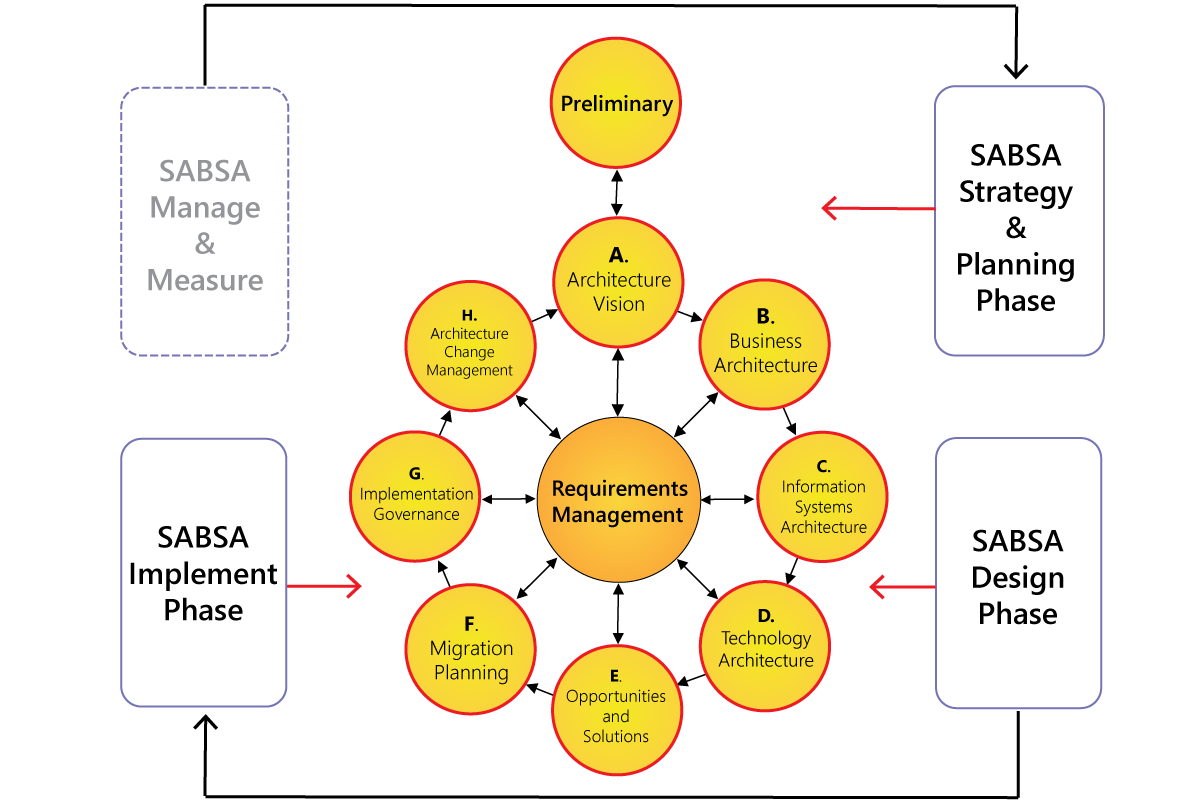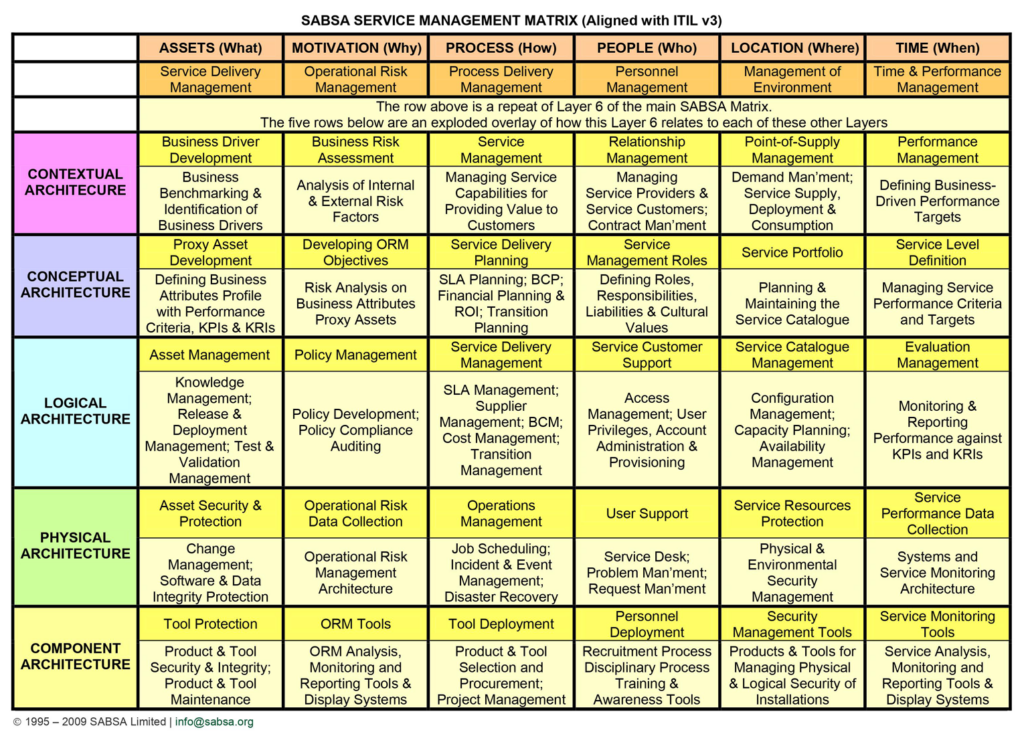SABSA Framework Overview
SABSA (Sherwood Applied Business Security Architecture) is a framework and methodology for creating business-driven security architectures: security is viewed as an enabler for business functions, not just a set of restrictions.
SABSA is made up of a series of integrated frameworks, models, methods and processes, used independently or as a holistic integrated enterprise solution, including:
- Business Requirements Engineering Framework (known as Attributes Profiling)
- Risk and Opportunity Management Framework
- Policy Architecture Framework
- Security Services-Oriented Architecture Framework
- Governance Framework
- Security Domain Framework
- Through-life Security Service Management & Performance Management Framework
Benefits of SABSA
The SABSA framework focuses on addressing security risks relevant to the business. It can be used alongside popular enterprise architecture frameworks and integrates well with TOGAF, ArchiMate and ITIL.
SABSA also provides tools for aligning security with standards like ISO 27001 .
Who Uses SABSA?
SABSA is widely used by architects across all industries globally, including commercial enterprises, Government Services and Defence & Intelligence communities.
SABSA Architecture & Modeling
The ABACUS architecture tool provides an out-of-the-box sample file which supports SABSA for applied business and security architecture.
Architects can also adapt or combine SABSA with ArchiMate, TOGAF, ITIL, NIST, BPMN and a range of other out-of-the-box frameworks also available in ABACUS if they require.
- Data Exchange: Architects can import & export data relevant to security architecture development using ABACUS integrations and API
- Collaboration: Architects, security teams, and business stakeholders can collaborate on security data and models
- Reporting and Visualization: ABACUS users can generate reports and visualizations that clearly illustrate the security architecture aligned with SABSA principles
- Robust Security: ABACUS provides best-in-class access management and security to ensure the integrity of sensitive security architecture data
SABSA Security Architecture
Using SABSA in ABACUS allows architects to incorporate SABSA’s structured approach to security architecture within the ABACUS architecture modeling environment.
This enables organizations to:
- Define and document security requirements: Use SABSA principles to identify and specify security requirements at different levels of the enterprise architecture, ensuring that security considerations are systematically addressed
- Map security controls: Use SABSA’s framework to map security controls to specific architectural components within the ABACUS model, enabling organizations to understand how security measures are implemented across the enterprise
- Analyze security posture: Leverage analytics and visualizations in ABACUS to assess the effectiveness of security controls and identify potential gaps or vulnerabilities in the architecture. SABSA provides a structured methodology for conducting security risk assessments and improving the overall security posture
- Communicate security concerns: Use dashboards and visualization in ABACUS to communicate security-related information effectively to stakeholders. Employ SABSA’s terminology and concepts to ensure clarity and alignment with industry standards
By integrating SABSA in ABACUS, organizations can strengthen their security architecture practices, improve risk management capabilities, and ensure that security considerations are integrated seamlessly into the broader enterprise architecture. This integration streamlines decision-making and enables organizations to mitigate security risks more effectively while supporting business objectives.
SABSA Tools & Techniques
Using SABSA in ABACUS provides:
- Business Alignment: Mapping security controls to business objectives
- Traceability: Track security decisions back to their originating business requirements
- Model Management: Create, edit, and manage SABSA models, representing security concepts (e.g., responsibility assignment matrices)
- Framework Integration: Integration with other architecture frameworks like TOGAF, ArchiMate
Communicating Security Architectures
Using a tool which supports the SABSA methodology can significantly enhance communication for security architects, providing:
- Clear Documentation and Templates: ABACUS can provide pre-built templates and consistent documentation across security architecture projects
- Visualizations and Layered Models: Visual representations like diagrams and layered models (which break down security considerations from different stakeholder perspectives) can be generated by the tool. This supports clear communication with both technical and non-technical audiences
SABSA Matrix
In the architecture model, each horizontal layer undergoes vertical segmentation, addressing inquiries such as what, why, how, who, where, and when. This segmentation, known as the SABSA Matrix, forms the basis of the SABSA content framework. A distinct matrix is also available for service management.
The SABSA Matrix (Image Source: SABSA Institute)
SABSA and TOGAF®
TOGAF is The Open Group framework used by 100,000+ practitioners worldwide to design, plan and implement enterprise and solution architecture. It is the most well-known and highly regarded EA standard framework.
By combining SABSA with TOGAF, teams can incorporate security considerations into the broader enterprise architecture development process outlined by TOGAF. This integration involves identifying security requirements, risks, and controls at each phase of the TOGAF Architecture Development Method (ADM).
The TOGAF – SABSA integration is based on three foundations:
- Risk Management
- Requirements Management
- The TOGAF ADM (Architecture Development Method)
By aligning SABSA principles with TOGAF’s structured approach, architects can ensure that security concerns are integrated well into the overall architecture. This improves the organizations’ ability to manage risk and support business objectives. This integration can also support better coordination between security architects and enterprise architects.

SABSA Lifecycle Phases Mapped to the TOGAF ADM (Image Source: SABSA Institute)
ABACUS is a TOGAF certified tool by The Open Group, providing conformance with all the TOGAF Framework requirements. ABACUS is also certified for ArchiMate.
SABSA and ArchiMate®
ArchiMate is a popular open and independent modeling language designed for enterprise architecture. Standardized by The Open Group, ArchiMate is used by architects to describe, analyze, and visualize the relationships between various business domains.
ArchiMate provides a rich set of elements and relationships that can map to the key concepts of SABSA.
For instance, ArchiMate’s business processes can represent activities within the organization. Application components can depict the IT systems delivering those services. Data objects within ArchiMate can be used to model the information flowing through the processes. This allows for a comprehensive view of the security posture of business services, enabling architects to identify potential vulnerabilities and design more secure systems.
By using ArchiMate’s visual representation with SABSA stakeholders across business services, enabling architects to identify potential vulnerabilities and design more secure systems.
Combining SABSA with ArchiMate involves integrating security concerns into the broader enterprise architecture using ArchiMate’s notation and framework. This integration allows organizations to depict security requirements, controls, and policies alongside other architectural elements such as business processes, applications, and infrastructure components. By utilizing ArchiMate’s standardized symbols and relationships, SABSA principles can be effectively communicated and aligned with broader enterprise objectives, facilitating better decision-making and risk management.
SABSA Resources:
SABSA Training and Certification For Architects


